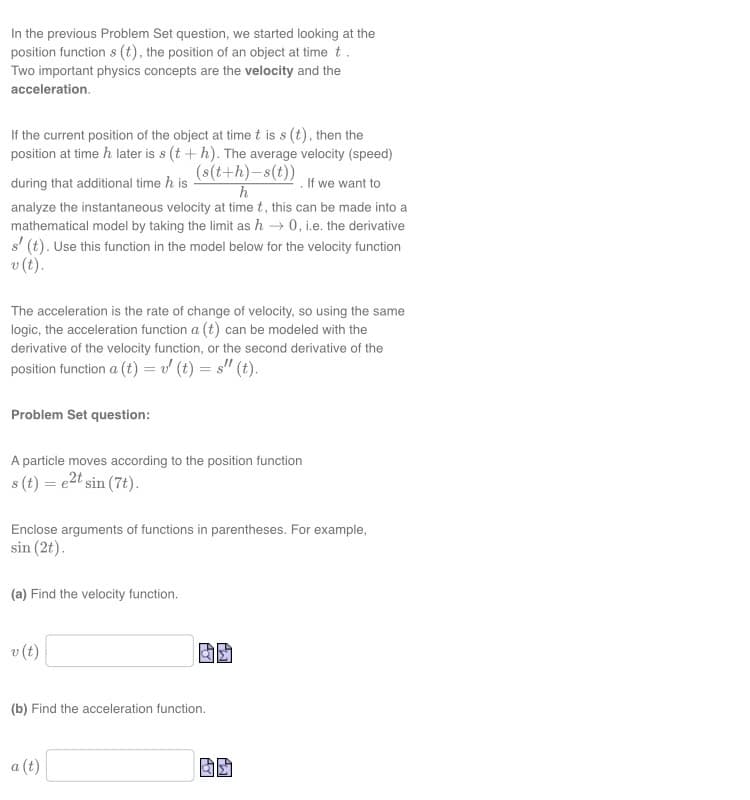A particle moves according to the position function s(t) = e2t sin (7t). Enclose arguments of functions in parentheses. For example, sin (2t). (a) Find the velocity function. v (t) (b) Find the acceleration function. a (t) 19
A particle moves according to the position function s(t) = e2t sin (7t). Enclose arguments of functions in parentheses. For example, sin (2t). (a) Find the velocity function. v (t) (b) Find the acceleration function. a (t) 19
College Algebra
7th Edition
ISBN:9781305115545
Author:James Stewart, Lothar Redlin, Saleem Watson
Publisher:James Stewart, Lothar Redlin, Saleem Watson
Chapter2: Functions
Section: Chapter Questions
Problem 30P: In this problem you are asked to find a function that models in real life situation and then use the...
Related questions
Question

Transcribed Image Text:In the previous Problem Set question, we started looking at the
position function s (t), the position of an object at time t.
Two important physics concepts are the velocity and the
acceleration.
If the current position of the object at time t is s (t), then the
position at time h later is s (t + h). The average velocity (speed)
(s(t+h)-s(t))
h
during that additional time h is
. If we want to
analyze the instantaneous velocity at time t, this can be made into a
mathematical model by taking the limit as h→0, i.e. the derivative
s' (t). Use this function in the model below for the velocity function
v (t).
The acceleration is the rate of change of velocity, so using the same
logic, the acceleration function a (t) can be modeled with the
derivative of the velocity function, or the second derivative of the
position function a (t) = v' (t)=s" (t).
Problem Set question:
A particle moves according to the position function
s(t) = e²t sin (7t).
Enclose arguments of functions in parentheses. For example,
sin (2t).
(a) Find the velocity function.
v (t)
(b) Find the acceleration function.
a (t)
Expert Solution
This question has been solved!
Explore an expertly crafted, step-by-step solution for a thorough understanding of key concepts.
Step by step
Solved in 2 steps

Recommended textbooks for you

College Algebra
Algebra
ISBN:
9781305115545
Author:
James Stewart, Lothar Redlin, Saleem Watson
Publisher:
Cengage Learning

Functions and Change: A Modeling Approach to Coll…
Algebra
ISBN:
9781337111348
Author:
Bruce Crauder, Benny Evans, Alan Noell
Publisher:
Cengage Learning

Algebra and Trigonometry (MindTap Course List)
Algebra
ISBN:
9781305071742
Author:
James Stewart, Lothar Redlin, Saleem Watson
Publisher:
Cengage Learning

College Algebra
Algebra
ISBN:
9781305115545
Author:
James Stewart, Lothar Redlin, Saleem Watson
Publisher:
Cengage Learning

Functions and Change: A Modeling Approach to Coll…
Algebra
ISBN:
9781337111348
Author:
Bruce Crauder, Benny Evans, Alan Noell
Publisher:
Cengage Learning

Algebra and Trigonometry (MindTap Course List)
Algebra
ISBN:
9781305071742
Author:
James Stewart, Lothar Redlin, Saleem Watson
Publisher:
Cengage Learning